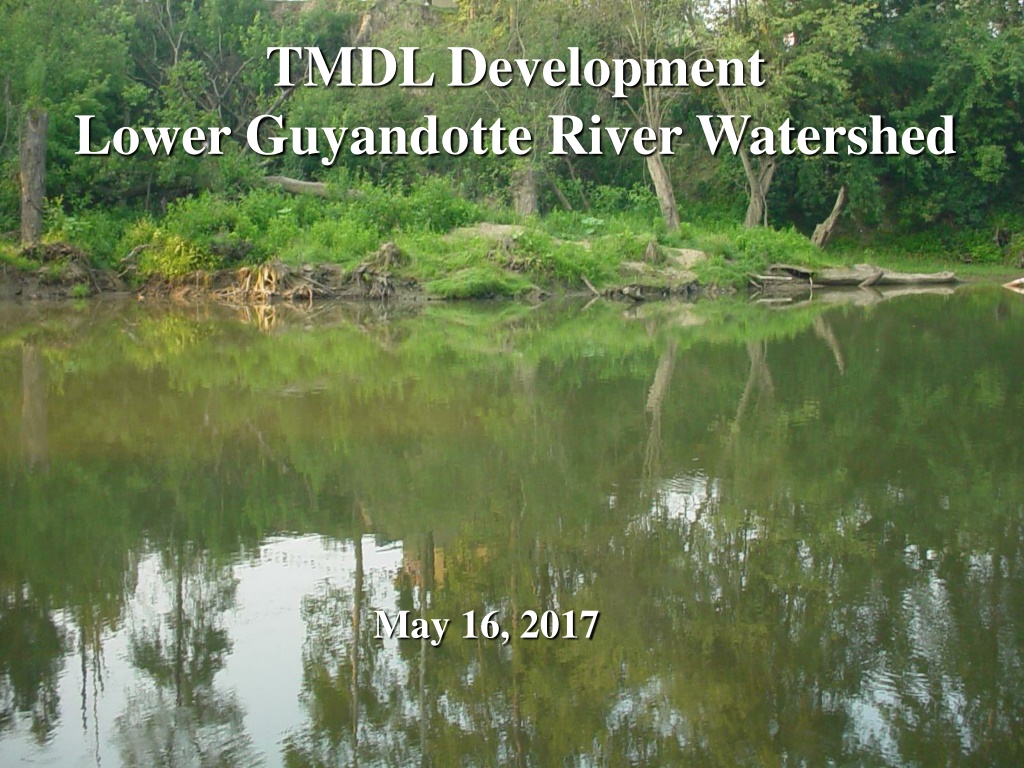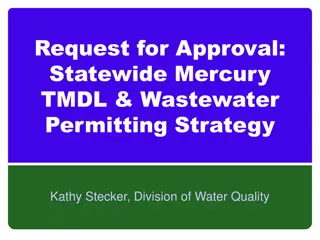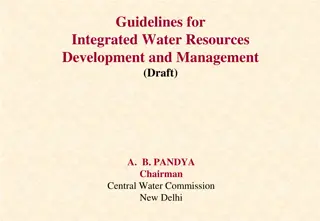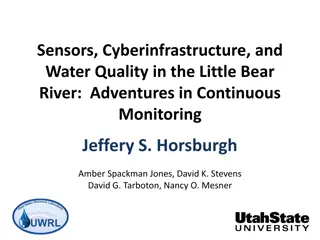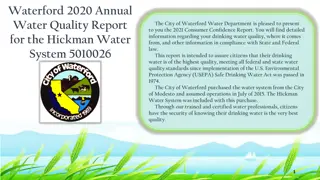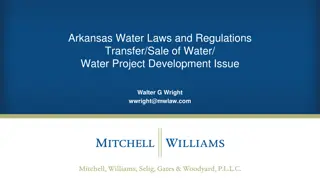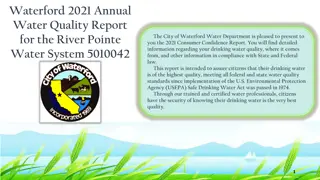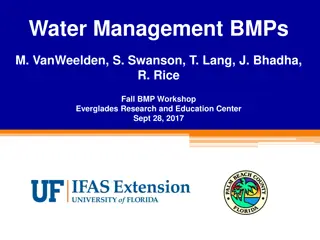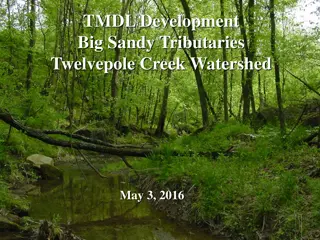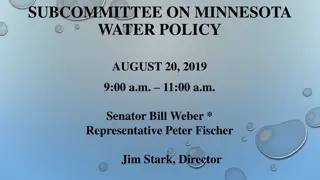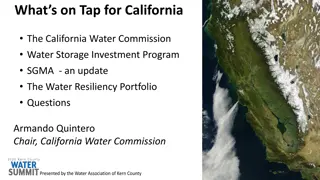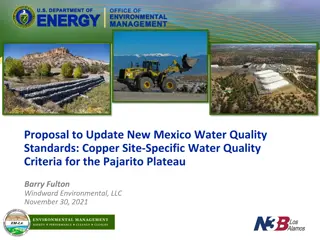Understanding TMDL Development in Water Quality Management
Exploring the Total Maximum Daily Load (TMDL) development process for impaired streams, including definitions of TMDL, impaired streams, numeric criteria for pollutants like fecal coliform bacteria and selenium, and narrative criteria to protect aquatic ecosystems. The content covers the necessity of TMDL development under the Clean Water Act, West Virginia Water Quality Standards, and the implications for local waters with impaired status.
Download Presentation

Please find below an Image/Link to download the presentation.
The content on the website is provided AS IS for your information and personal use only. It may not be sold, licensed, or shared on other websites without obtaining consent from the author. Download presentation by click this link. If you encounter any issues during the download, it is possible that the publisher has removed the file from their server.
E N D
Presentation Transcript
TMDL Development Lower Guyandotte River Watershed May 16, 2017
Agenda Background information on Water Quality Standards, impaired waters and TMDLs Brief history of WV TMDL development Overview of WVDEP s TMDL process Discussion of local impaired waters and their TMDL timeline Pre-TMDL Monitoring Plan for local waters Discussion Free form questions and answers
Whats a TMDL? Total Maximum Daily Load How much of a pollutant/s a stream can receive and remain healthy TMDL is a pollutant budget prescribes reduction in pollutants, where needed, that result in the restoration of an impaired stream TMDL development is required by Clean Water Act for all impaired streams
Whats an impaired stream? Stream that doesn t meet water quality standards West Virginia Water Quality Standards are codified in 47 CSR 2 Standards include designated uses for WV waters and water quality criteria to protect those uses Criteria can be numeric or narrative Impaired streams (streams that are not meeting criteria) get placed on the 303(d) List
Numeric Criteria Fecal Coliform Bacteria Human Health Protection (Water Contact) 200 counts/100ml as a monthly geometric mean No more than 10% of samples in a month exceed 400 counts/100ml Total Iron HumanHealth/Aquatic Life Protection 1.5 mg/l as a 4 day average concentration (warmwater) Not to be exceeded more than once every 3 years Not to exceed 1.5 mg/l (Public Water)
Numeric Criteria Example Selenium Aquatic Life/Public Drinking water Aquatic life criteria 20 ug/l as a 1 hour average concentration 5 ug/l as a 4 day average concentration Not to be exceeded more than once in three years Public Water - Not to exceed 50 ug/l
Narrative Criteria Biological Impairment Conditions Not Allowable in State Waters (47 CSR 2-3.2i) .....no significant adverse impact to the chemical, physical, hydrologic or biological components of aquatic ecosystems shall be allowed.
WVDEP TMDL Process Stream Selection Pre-TMDL monitoring, source identification and characterization Contract to model water quality and hydrology Allocation process Draft Report development Finalization including EPA approval
Process Highlights Synchronized with WV Watershed Management Framework 48 month process (Stream selection EPA approval) Multiple opportunities for public outreach/ stakeholder input Pre-TMDL water quality monitoring Source identification and characterization
TMDL Stream Selection Process Spread development over State Evaluate list of impaired waters Consider Watershed Management Framework Maximize efficiency focus geographically address all known or suspected impairments Resources
TMDL Development Stream Selection Process Watershed Management Framework Consideration TMDL Development Hydrologic Group C Within HG C candidate watersheds = Gauley, Lower Guyandotte, Middle Ohio North, Middle Ohio South, Potomac Drains, Tug Fork
TMDL Stream Selection Process DEP advertised proposal of Lower Guyandotte River Watershed for TMDL development & provided opportunity for public comment (February 5th March 15th), No Comments received. Watershed was selected for TMDL development Due to resource constraints, a TMDL for Barboursville Lake is not proposed as part of this project. TMDLs will be developed for any new water quality impairments identified in pre-TMDL monitoring.
HG C4 TMDL Timeline Stream selection 1/31 3/3 Monitoring plan development 3/14 - 3/20 Outreach (TMDL process + monitoring plan) 5/16 6/16 Stream Monitoring and Source Tracking 7/2017 6/2018
HG C4 TMDL Timeline Modeling 10/2018 3/2020 Outreach Meeting 7/2019 - 9/2019 Draft TMDLs (Internal Review) 3/2020 Outreach (Public Notice/Comment on Drafts) 5/2020 7/2020
HG C4 TMDL Timeline Finalization (including EPA approval) 12/2020 Implementation begins 7/2022 NPDES Water Permits 1/2023 NPDES Mining Permits
Pre-TMDL Monitoring Plan Goal to generate robust/current data to: Make accurate impairment assessments Calibrate watershed models Quantify the impacts of significant pollutant sources Today s presentation is a preliminary plan; to be refined via WVDEP field recon and stakeholder input
Pre-TMDL Monitoring Plan Monitoring period : July 2017 June 2018 Sampling frequency Water chemistry (monthly) & selected parameters (quarterly) Flow measurement (selected locations monthly) Benthic macroinvertebrates (at least once during appropriate sampling period) RBP habitat evaluations (at time of benthic macroinvertebrate assessments)
Pre-TMDL Monitoring Plan Sample site map on DEP webpage - GIS available Impairment/potential impairment sampling parameters include TSS, T. & Dis. Iron Fecal coliform T. & Dis. Aluminum T. Manganese upstream of water intakes T. Selenium (selected sites & background) Biology benthic macroinvertebrates collected at least once during applicable season to evaluate narrative criteria Fish to be assessed at some sites 305 sites on 230 streams
Source Tracking Efforts Abandoned Mine Lands Limits of sewage collection systems Assessment of failing onsite systems AFOs, Livestock counts, livestock stream access Riparian zone condition (Runoff potential) Unmapped road density Qualitative assessment of sediment sources Active Mining Point Source Info
Stakeholder Input General comments regarding plan s adequacy in addressing goals Does the plan provide for monitoring of particularly bad or good streams that you know about? Does the plan provide monitoring sufficient to characterize significant pollutant sources? Do you have water quality data to contribute?
Future Input Opportunities Outreach meeting/s Summer 2019 Public Meeting to present Draft TMDL and formal Public Notice/Public Comment Summer 2020
WVDEP Contact Information Contact: Steve Young Stephen.A.Young@wv.gov Tele: (304) 926-0499 Ext 1042; FAX: (304) 926-0496 601 57th Street SE, Charleston WV 25304 www.dep.wv.gov Select Water and Waste Home On left select Watershed Management, click on Total Maximum Daily Load
